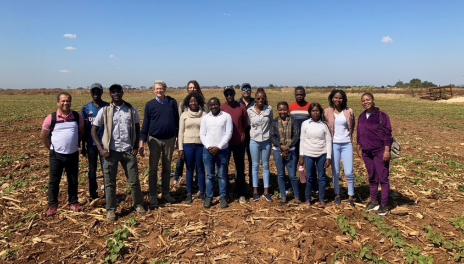Dry bean research returns good worldwide economic value
Dry bean research returns good worldwide economic value
An economic study which analyzed 40 years of data from international agricultural research efforts led by U.S. universities, and financed by the United States Agency for International Development (USAID), showed that an initial investment of $1.24 billion has returned more than $10 billion, or more than eight dollars for each dollar invested, worldwide.
The economic study, “Economists Study Impact of International Agricultural Research at U.S. Universities”, was conducted by Kansas State University (KSU) economics researchers and reported by Benjamin Kohl on July 21, 2022.
Among those research programs cited in the study is the Feed the Future Innovation Lab for Legume Systems Research, a research and capacity building development program managed by Michigan State University that focuses on grain legumes in West and Southern Africa.
One of the Legume Innovation Lab projects is led by North Dakota State University (NDSU) Department of Plant Sciences dry bean breeder Juan Osorno and bean genomicist Phil McClean.
Between 2012 and 2018, Osorno and McClean led research efforts in Guatemala for the genetic improvement of climbing beans in the western highlands of Guatemala. Their current research program is the Genetic Improvement of Dry Beans for Bruchid Resistance for Southern Africa.
Mozambique and Zambia provide close to 30 percent of the total common bean (Phaseolus vulgaris) production in Africa. However, bean weevil (bruchid) infestations resulting in over 48 percent quality and quantity loss in stored beans are a key cause of some of the highest levels of malnutrition and poverty in the world. The collaborative efforts between bean breeders and geneticists Osorno and McClean, Carlos Urrea (University of Nebraska), and Kelvin Kamfwa (University of Zambia) aim to develop bruchid-resistant germplasm, with the goal of developing new bruchid-resistant varieties with good agronomic performance and improved storage and cooking properties.
Already considered a “game changer” in the bean value chain in southern Africa, developing these bruchid resistant varieties will improve food safety in the region by offering a new product that can be stored safely for longer periods of time without losing quality. In addition, the project will improve the technical knowledge of bean smallholder farmers, bean scientists, and other stakeholders in the region through training the next generation of plant scientists (breeders) for the region.
Although COVID-19 travel restrictions didn’t allow Osorno to visit in person, constant interaction with collaborators in Zambia (Kamfwa) and Mozambique (Celestina Jochua) via Zoom and other virtual tools allowed the project to make progress. Osorno finally traveled to Mozambique and Zambia, South Africa July 19-30 to review progress on work that started in January 2020. They toured research plots, storage facilities, greenhouse materials and bruchid screening laboratories. Osorno was pleased to see colleagues in person after the initial research had been conducted while under pandemic travel limitations. “I was impressed to see that in spite of the initial challenges brought by COVID-19, the research never stopped”, says Osorno.
Osorno is proud the research has added North Dakota to the global initiative to improve and increase legume production in developing countries, as well as established production areas worldwide. The plan is to release the first bruchid-resistant variety with local adaptation and acceptable commercial seed type within the region sometime next year.
Article link Economists Study Impact of International Agricultural Research at U.S. Universities
Link for Genetic Improvement of Dry Beans for Bruchid Resistance for Southern Africa
Link for Feed the Future Innovation Lab for Legume Systems Research
This research was made possible through support provided by the U.S. Agency for International Development (USAID) under the Feed the Future Innovation Lab for Legume Systems Research. The opinions expressed herein are those of the authors and do not necessarily reflect the views of USAID or the United States Government.
